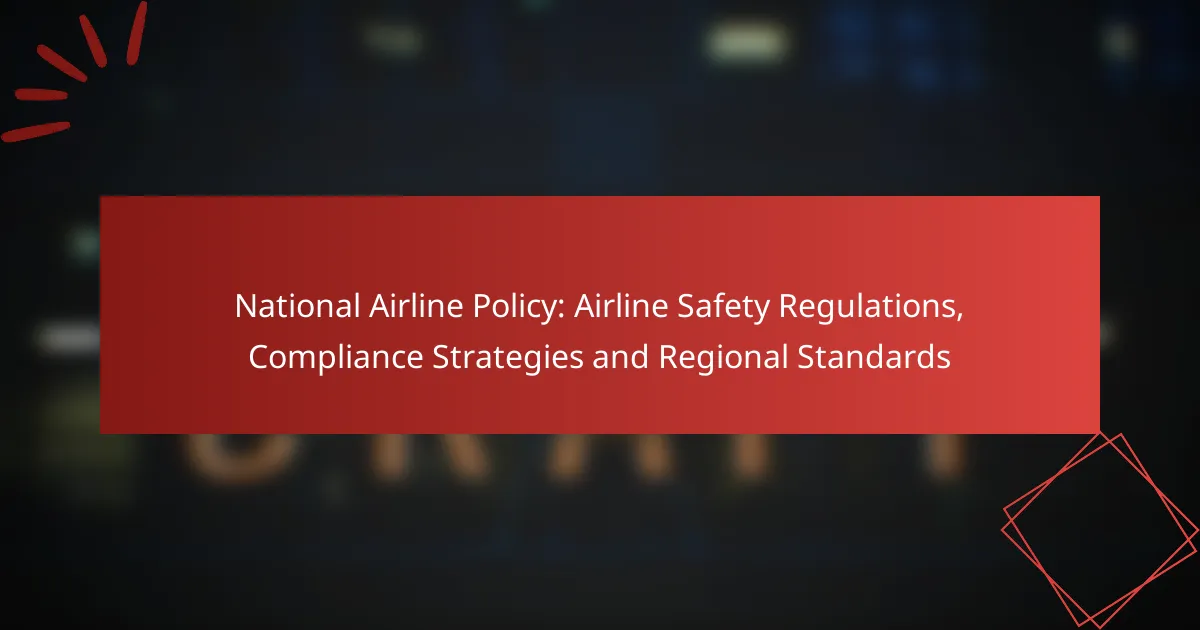The National Airline Policy emphasizes the importance of stringent airline safety regulations, primarily overseen by the Federal Aviation Administration (FAA) in the United States and the European Union Aviation Safety Agency (EASA) in Europe. These regulations are designed to enhance passenger safety through comprehensive guidelines covering operations, maintenance, and safety management systems. Airlines implement compliance strategies such as rigorous audits and training programs to uphold these standards and mitigate risks associated with air travel.
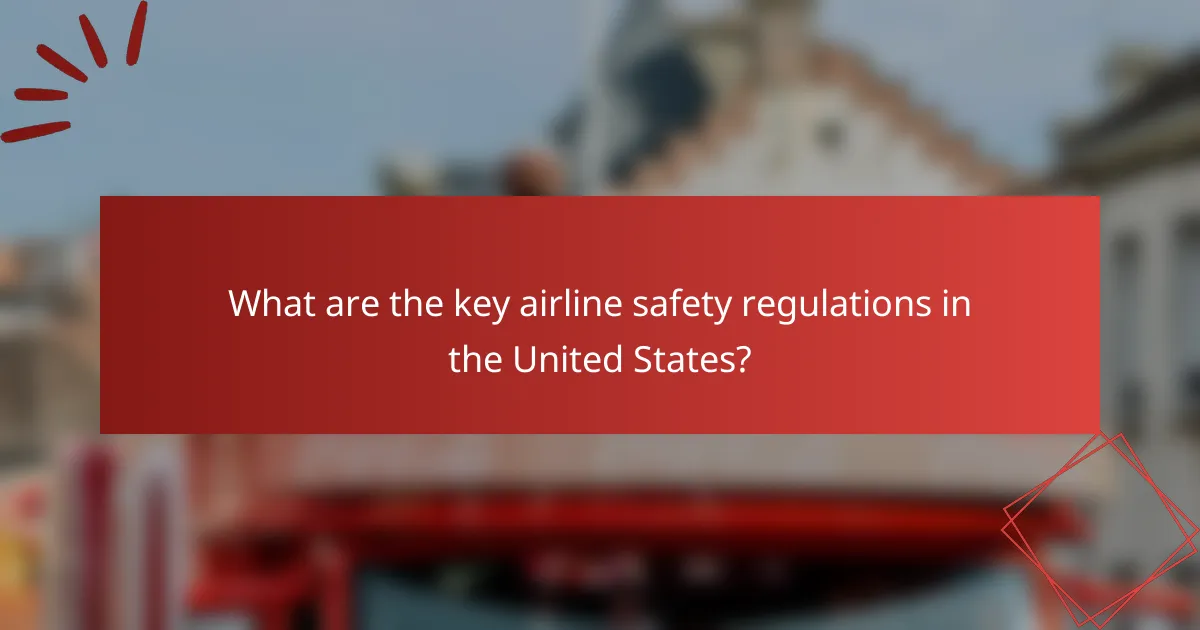
What are the key airline safety regulations in the United States?
The key airline safety regulations in the United States are primarily governed by the Federal Aviation Administration (FAA) and include a comprehensive set of guidelines aimed at ensuring the safety of air travel. These regulations cover various aspects of airline operations, maintenance, and safety management systems to minimize risks and enhance passenger safety.
Federal Aviation Administration (FAA) guidelines
The FAA establishes and enforces regulations that airlines must follow to ensure safety in aviation operations. These guidelines include requirements for pilot training, aircraft maintenance, and operational procedures. Airlines are subject to regular inspections and audits to ensure compliance with these standards.
Key areas of FAA guidelines include the certification of aircraft and pilots, air traffic control procedures, and safety management systems. Airlines must maintain detailed records and implement safety protocols to address potential hazards effectively.
International Civil Aviation Organization (ICAO) standards
The ICAO sets global standards for aviation safety, which member countries, including the United States, are encouraged to adopt. These standards cover a wide range of operational areas, including airworthiness, flight operations, and safety management. Compliance with ICAO standards helps ensure that airlines operate safely and efficiently across international borders.
Airlines often align their safety practices with ICAO standards to facilitate international operations and enhance safety measures. This alignment includes adhering to recommended practices and participating in safety audits conducted by ICAO member states.
Airline Safety Management Systems
Airline Safety Management Systems (SMS) are structured frameworks that help airlines manage safety risks effectively. An SMS involves systematic processes for identifying hazards, assessing risks, and implementing safety measures. This proactive approach is essential for maintaining high safety standards in airline operations.
Implementing an SMS requires airlines to foster a safety culture, encourage reporting of safety issues, and conduct regular training for staff. By prioritizing safety management, airlines can reduce incidents and enhance overall operational safety.
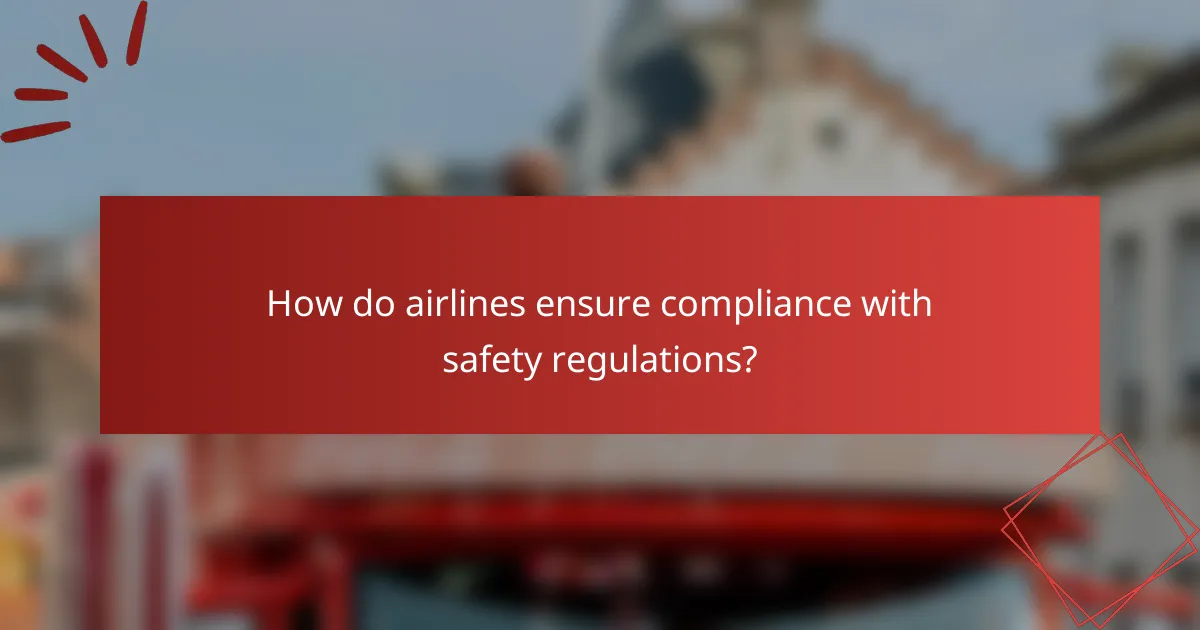
How do airlines ensure compliance with safety regulations?
Airlines ensure compliance with safety regulations through a combination of rigorous audits, comprehensive training programs, and the implementation of safety management systems. These strategies help maintain high safety standards and mitigate risks associated with air travel.
Regular safety audits
Regular safety audits are essential for identifying potential hazards and ensuring adherence to safety regulations. Airlines typically conduct these audits at least annually, but many opt for more frequent checks to stay ahead of compliance requirements.
During an audit, various aspects such as aircraft maintenance, operational procedures, and safety equipment are evaluated. This process helps airlines pinpoint weaknesses and implement corrective actions promptly, enhancing overall safety performance.
Training programs for staff
Training programs for staff are crucial in fostering a safety-oriented culture within airlines. These programs cover a range of topics, including emergency procedures, equipment handling, and regulatory updates, ensuring that all personnel are well-prepared for various scenarios.
Airlines often use simulations and hands-on training to reinforce learning. Regular refresher courses are also important, as they help staff stay current with evolving safety regulations and best practices.
Implementation of safety management systems
Implementing safety management systems (SMS) allows airlines to proactively manage safety risks. An SMS provides a structured framework for identifying hazards, assessing risks, and implementing safety measures, which is essential for compliance with international standards.
Airlines typically integrate their SMS into daily operations, ensuring that safety considerations are part of every decision. This systematic approach not only helps in meeting regulatory requirements but also promotes continuous improvement in safety performance.
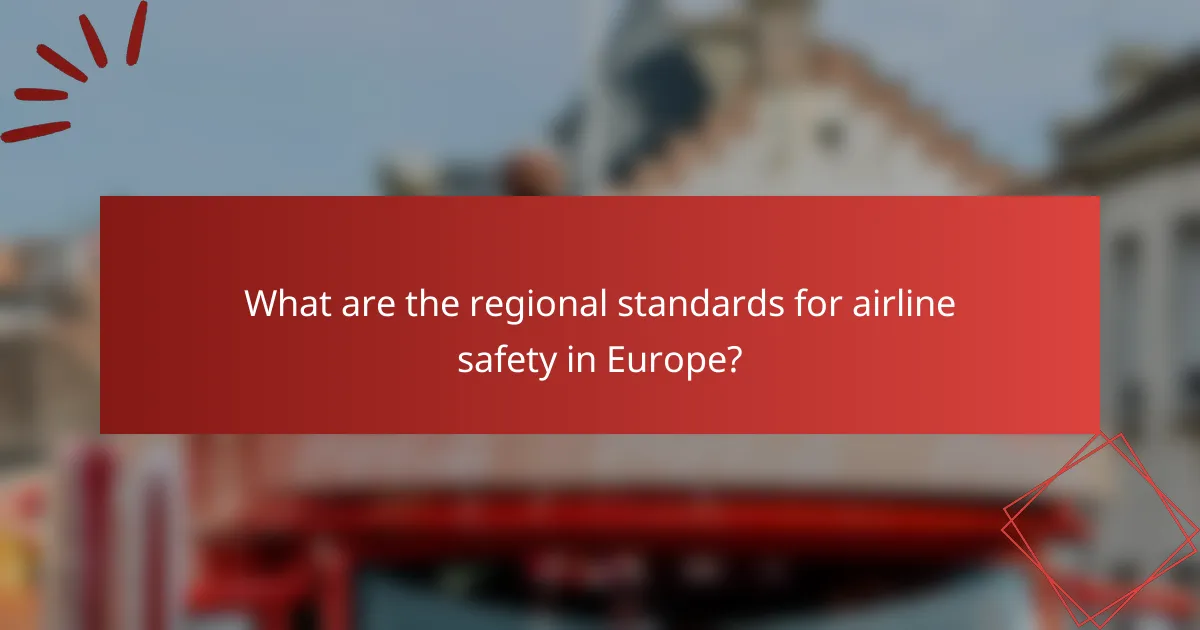
What are the regional standards for airline safety in Europe?
Regional standards for airline safety in Europe are primarily governed by the European Union Aviation Safety Agency (EASA), which sets comprehensive regulations to ensure safe air travel. These standards encompass aircraft design, maintenance, operational procedures, and crew training, aiming to maintain high safety levels across member states.
European Union Aviation Safety Agency (EASA) regulations
EASA regulations are designed to harmonize aviation safety standards across Europe, ensuring that all airlines operating within the EU adhere to the same rigorous safety protocols. These regulations cover various aspects, including airworthiness, pilot licensing, and operational safety management systems.
Key components of EASA regulations include regular safety audits, mandatory reporting of incidents, and stringent maintenance requirements. Airlines must comply with these standards to maintain their operating licenses and ensure passenger safety.
Differences from FAA standards
While both EASA and the Federal Aviation Administration (FAA) in the United States aim to ensure aviation safety, their approaches can differ significantly. EASA tends to emphasize a more prescriptive regulatory framework, while the FAA often adopts a performance-based approach that allows for more flexibility in compliance.
For example, EASA requires specific maintenance schedules for aircraft, whereas the FAA may permit airlines to develop their own maintenance programs as long as they meet safety outcomes. These differences can affect how airlines operate and manage safety protocols across regions.
Impact of Brexit on airline safety regulations
Brexit has introduced complexities in airline safety regulations for UK-based airlines, which must now navigate both EASA and UK Civil Aviation Authority (CAA) standards. While the UK initially retained EASA regulations, it has begun to develop its own framework, which could diverge over time.
This divergence may lead to increased compliance costs for airlines operating in both regions, as they will need to adhere to different sets of regulations. Additionally, UK airlines may face challenges in maintaining operational approvals within the EU, impacting their ability to serve European routes effectively.

What compliance strategies can airlines adopt?
Airlines can adopt several compliance strategies to enhance safety and meet regulatory requirements. These strategies focus on risk assessment, continuous monitoring, and collaboration with regulatory bodies to ensure adherence to safety standards.
Risk assessment frameworks
Implementing a robust risk assessment framework is crucial for airlines to identify potential safety hazards. This involves systematic processes to evaluate risks associated with operations, maintenance, and crew performance.
Airlines should consider using established methodologies such as the Safety Management System (SMS) or the Bowtie model. These frameworks help in categorizing risks and prioritizing them based on their potential impact, allowing for targeted mitigation strategies.
Continuous monitoring and reporting
Continuous monitoring and reporting are essential for maintaining compliance with safety regulations. Airlines should utilize data analytics and real-time monitoring systems to track safety performance indicators and identify trends over time.
Regular reporting to management and regulatory authorities ensures transparency and accountability. Airlines can implement automated reporting tools that streamline data collection and analysis, making it easier to respond to safety issues promptly.
Collaboration with regulatory bodies
Collaboration with regulatory bodies is vital for airlines to stay updated on safety regulations and best practices. Engaging with authorities such as the FAA or EASA can provide insights into compliance requirements and emerging safety trends.
Airlines should participate in industry forums and workshops organized by regulatory agencies. This involvement not only enhances knowledge but also fosters relationships that can facilitate smoother compliance processes and support during audits or inspections.

How do emerging technologies impact airline safety regulations?
Emerging technologies significantly enhance airline safety regulations by introducing innovative monitoring systems and advanced cockpit tools. These advancements help airlines comply with safety standards more effectively and improve overall operational safety.
Use of artificial intelligence in safety monitoring
Artificial intelligence (AI) plays a crucial role in safety monitoring by analyzing vast amounts of data from various sources, such as flight data recorders and maintenance logs. AI systems can identify patterns and anomalies that may indicate potential safety issues, allowing for proactive measures to be taken.
For instance, predictive maintenance powered by AI can forecast equipment failures before they occur, reducing downtime and enhancing safety. Airlines adopting AI-driven solutions often see improvements in compliance with safety regulations and a reduction in incident rates.
Implementation of advanced cockpit technologies
Advanced cockpit technologies, such as enhanced vision systems and automated flight controls, contribute to improved safety by providing pilots with better situational awareness. These technologies help mitigate human error, which is a significant factor in aviation incidents.
Examples include head-up displays (HUDs) that project critical flight information directly in the pilot’s line of sight, allowing for more informed decision-making. As these technologies evolve, regulatory bodies may update safety regulations to incorporate new standards for their use.
Impact of drone technology on safety regulations
The rise of drone technology has prompted regulators to reassess existing safety regulations to address new challenges. Drones are increasingly used for tasks such as inspections and surveillance, which can enhance safety but also introduce risks if not properly managed.
Regulatory frameworks are evolving to include guidelines for drone operations, ensuring they do not interfere with manned aircraft. For example, the Federal Aviation Administration (FAA) in the United States has established rules governing drone flight paths and operational limits to maintain safety in shared airspace.
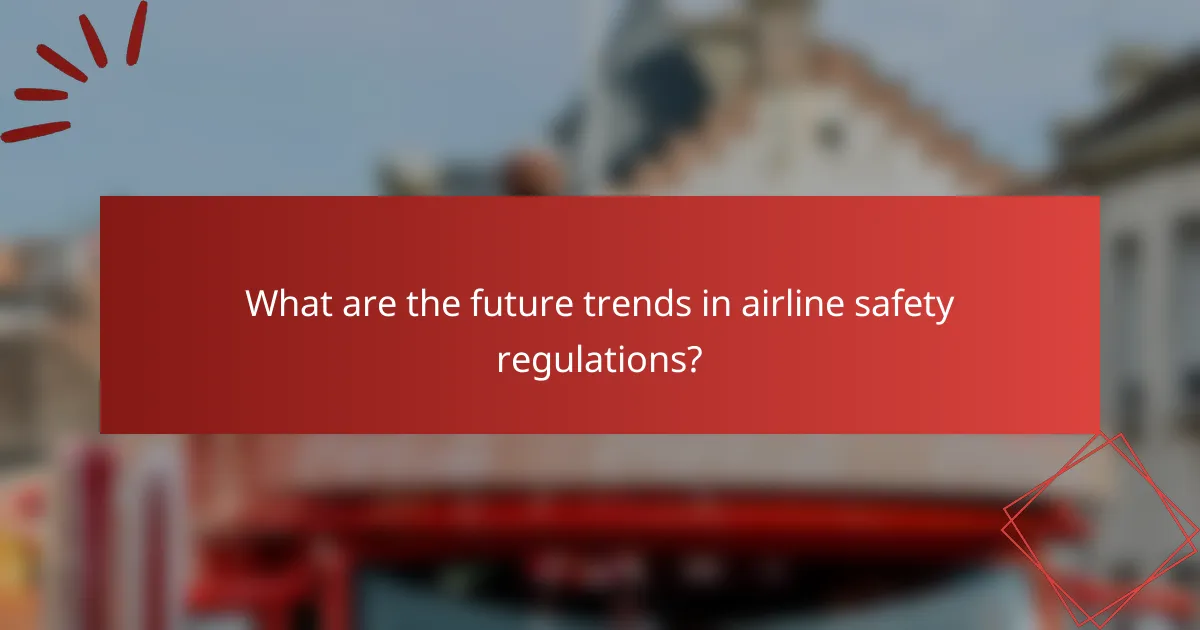
What are the future trends in airline safety regulations?
Future trends in airline safety regulations focus on enhancing safety through technology, data analytics, and increased collaboration among global aviation authorities. These trends aim to improve compliance and adapt to emerging risks in the aviation sector.
Increased Use of Technology
Airlines are increasingly adopting advanced technologies such as artificial intelligence, machine learning, and predictive analytics to enhance safety measures. These technologies can analyze vast amounts of data to identify potential safety risks before they escalate, allowing for proactive interventions.
For example, AI can monitor aircraft systems in real-time, detecting anomalies that may indicate maintenance issues. This shift towards technology-driven safety measures is expected to reduce incidents significantly over the coming years.
Enhanced Data Sharing and Collaboration
Collaboration among airlines, regulatory bodies, and safety organizations is becoming more critical. By sharing data on incidents and safety practices, stakeholders can develop more effective safety protocols and standards. This trend is particularly relevant in regions with diverse regulatory environments.
For instance, initiatives like the Aviation Safety Information Analysis and Sharing (ASIAS) program in the United States encourage data sharing to enhance overall safety. Such collaborative efforts can lead to more uniform safety standards across different jurisdictions.
Focus on Human Factors and Training
Future regulations are likely to place greater emphasis on human factors in aviation safety. This includes improving pilot training programs and addressing issues such as fatigue management and decision-making under pressure. Acknowledging the human element is essential for reducing errors that can lead to accidents.
Airlines may implement more rigorous training simulations that replicate high-stress scenarios, ensuring that crew members are better prepared for real-world challenges. This proactive approach to human factors can significantly enhance overall safety outcomes.
